What would a blog that includes fermenting be without the requisite kombucha post? I must admit that I became a kombucha junkie many years ago, even before it was a “thing”. People thought I was crazy, but it made me feel good and soon everyone caught on. The price tag, however, made me wonder if I could make it myself. I got the book Wild Fermentation by Sandor Katz and soon I was brewing my own ‘booch!
Because there are a million and a half blog posts on how to make kombucha (this one from Bonzai Aphrodite is one of my faves), I’m going to do an overview here on the basic process. The real part I will focus on is how to make hibiscus kombucha via a second ferment.
Kombucha SCOBY
The first thing that you need to start a batch of kombucha is a SCOBY, which stands for Symbiotic Culture Of Bacteria and Yeast. Sounds weird, I know, but trust me, it’s a good thing! Luckily for you it’s pretty easy these days to acquire one.
The best way is to get a SCOBY baby from a friend who is already brewing kombucha, but if you don’t know anyone who has one you can always order one online from Kombucha Kamp or Amazon. What a lucky world we live in today!
It is a weird looking thing, that’s for sure. It sort of looks like a pancake.
You will also need about 2 cups of starter kombucha liquid. You can get it from the person that you get the SCOBY from, or if you order one online it should come with some kombucha liquid. If it doesn’t, or if it only comes with a small amount, you can always run to the store and buy a bottle of plain raw kombucha to use as your starter.
How to Make Kombucha
To make a gallon batch of kombucha, start by brewing about a half gallon or a little more of black tea. I like to make it pretty strong by adding several spoonfuls of loose leaf tea to the hot water, but you can also use tea bags if you wish. Just make sure that it’s plain black tea, no flavorings.
Let it steep for a little while, then strain the tea into a gallon glass jar.
While it’s still warm, add 1 cup of sugar to the tea and stir to dissolve. Many recipes I see online call for white sugar, but I’ve always used raw sugar with no problem. Add cold water until the jar is about ¾ full.
The next step is to add your SCOBY and starter kombucha, but you need to make sure that your tea isn’t too hot or else you’ll kill your SCOBY! Room temperature or slightly warmer is perfect. If it feels a little too warm you can always toss in a few ice cubes to help cool it down, then add your SCOBY and starter liquid.
Your SCOBY will probably float towards the top, but don’t worry if it doesn’t. Cover the jar with a clean towel or cheesecloth and a rubber band and put in a warm and out of the way spot in your kitchen.
Try not to disturb it too much while it’s fermenting. After a week or two a whole new SCOBY baby will have formed on the surface and the liquid should taste somewhat vinegary, just like kombucha!
Pretty cool! Give the baby away to a friend who wants to brew their own kombucha, or continue to brew yours with an extra SCOBY. Now you’ll want to set aside your SCOBY and 2 cups of liquid for your next batch.
You can go ahead and drink this batch as is, but to make it even better you’ll want to do what’s called a second ferment. This is where you get to add your flavorings of choice.
Hibiscus Kombucha Second Ferment
I decided to use hibiscus because it’s a wonderful flavor and it also lowers blood pressure. I made a strong tea using Red Zinger tea from Celestial Seasonings, which are made with hibiscus, but you could also buy dried hibiscus flowers from Mountain Rose Herbs (my favorite place to buy high quality, organic dried herbs) and make a tea from them.
Add the hibiscus tea to the kombucha.
Then transfer the hibiscus kombucha mix into flip top bottles using a small funnel.
Seal the bottles and let them sit at room temperature for a few days. This is what’s called the second ferment. Test one out to see how bubbly it is, and let them go a little longer if need be.
Once it is nice a bubbly to your liking, put the bottles in the fridge and drink whenever!
Like I said before, I’ve been brewing kombucha for quite a while, but have only gotten into the second ferment more recently. I love this idea because you can use all sorts of flavors from juices to teas to make your ‘booch even tastier.
More Kombucha Flavors
A cold glass of this hibiscus kombucha on a hot day really hits the spot, that’s for sure! It’s starting to make me think about new flavors… Hmm, I wonder what lemon balm or rose hip kombucha would be like? I just might have to try it!
Hibiscus Kombucha
Equipment
Ingredients
- kombucha SCOBY
- 2 cups kombucha liquid
- ½ gallon water
- few spoonfuls loose leaf black tea or plain black tea bags
- 1 cup sugar
- 1/2 cup dried hibiscus flowers or a few Red Zinger tea bags
Instructions
Kombucha First Ferment
- To make a gallon batch of kombucha, start by brewing about a half gallon of black tea. Add several spoonfuls of loose leaf tea to the hot water, but you can also use tea bags if you wish.
- Let it steep for a little while, then strain the tea into a gallon glass jar
- While it’s still warm, add sugar to the tea and stir to dissolve.
- Add cold water until the jar is about 3/4 full.
- Add your SCOBY and starter kombucha to room temperature tea.
- Cover the jar with a clean towel or cheesecloth and a rubber band and put in a warm and out of the way spot in your kitchen. Do not disturb during fermentation.
- After a week or two a whole new SCOBY baby will have formed on the surface and the liquid should taste somewhat vinegary, just like kombucha! Set aside your SCOBY and 2 cups of liquid for your next batch.
Hibiscus Second Ferment
- Prepare hibiscus tea and add it to the kombucha.
- Transfer the hibiscus kombucha mix into flip top bottles using a small funnel.
- Seal the bottles and let them sit at room temperature for a few days. Open the bottles to let the gasses escape once a day. (This is called "burping.")
- Test one and see if it is to your taste. Once it is nice a bubbly to your liking, put the bottles in the fridge and drink whenever!
Notes
- Many recipes I see online call for using white sugar in kombucha, but I’ve always used raw sugar with no problem.
Nutrition

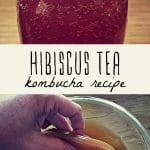
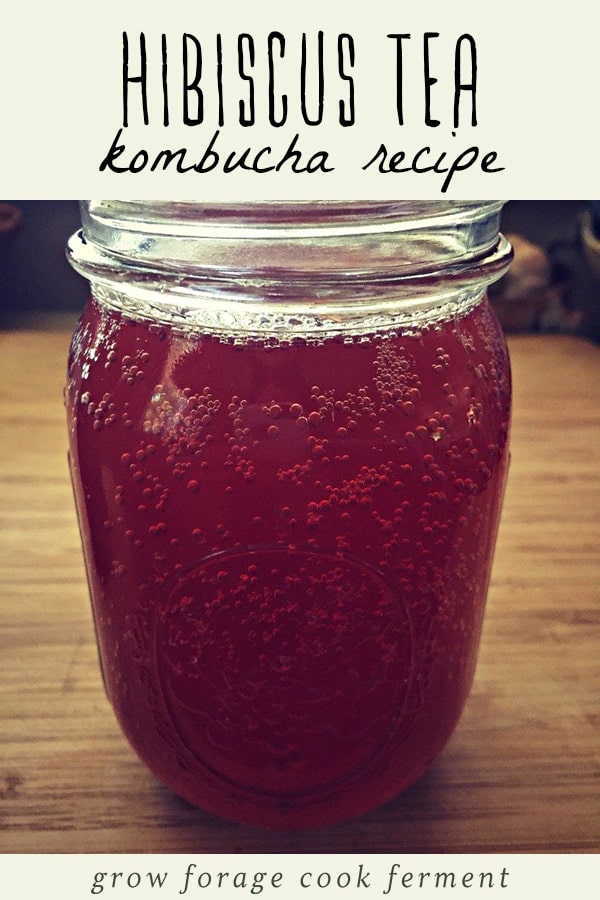
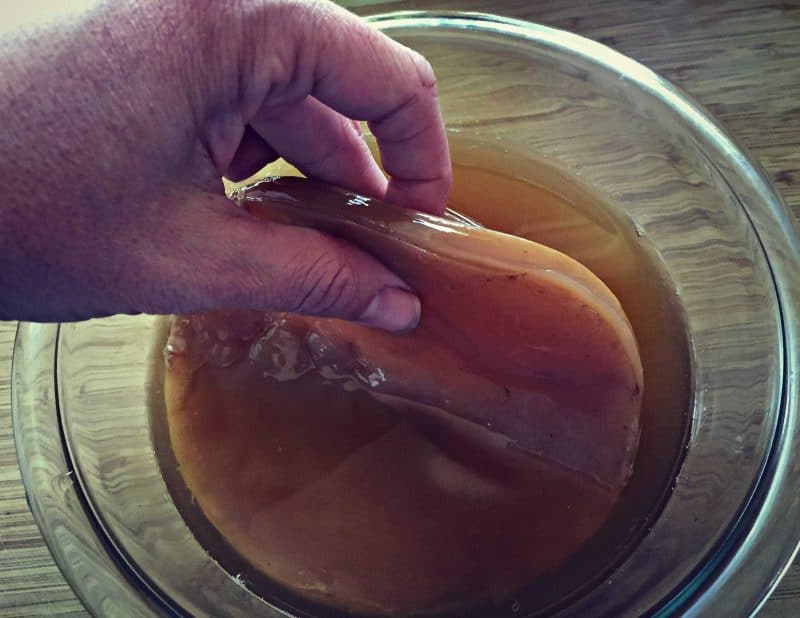
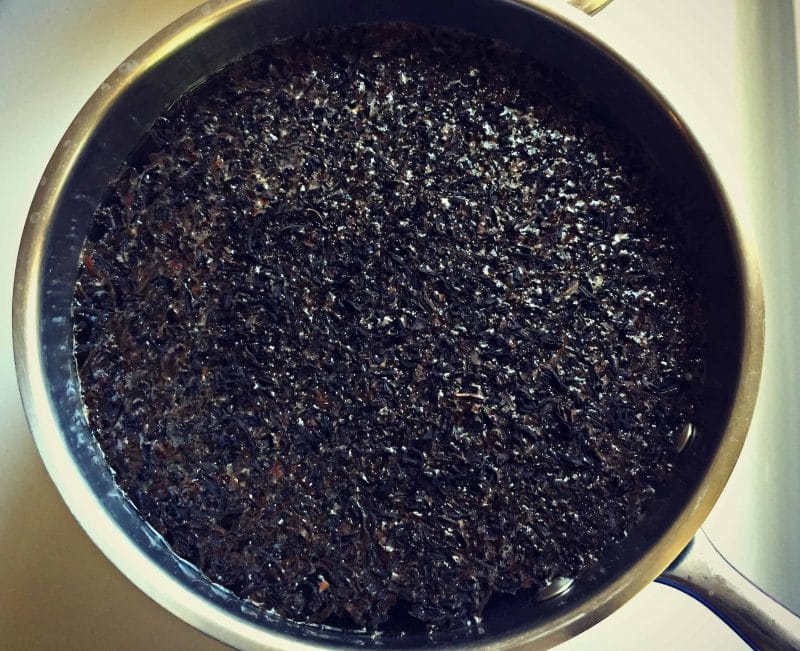
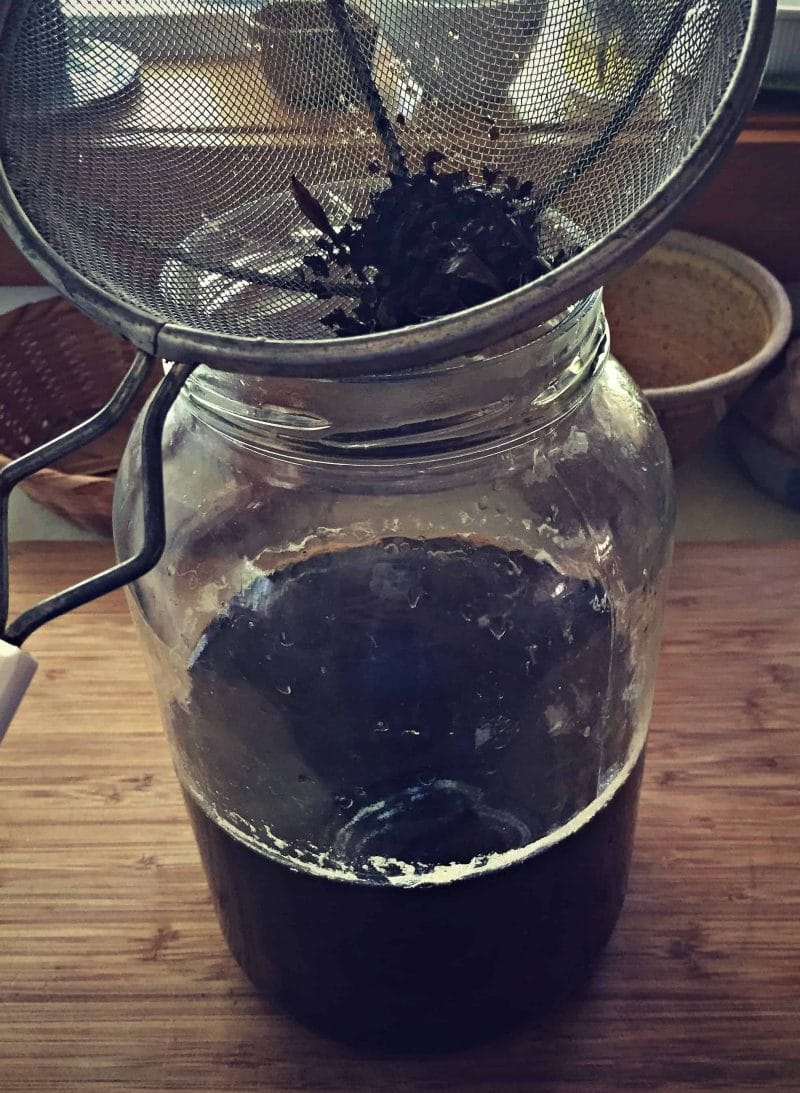
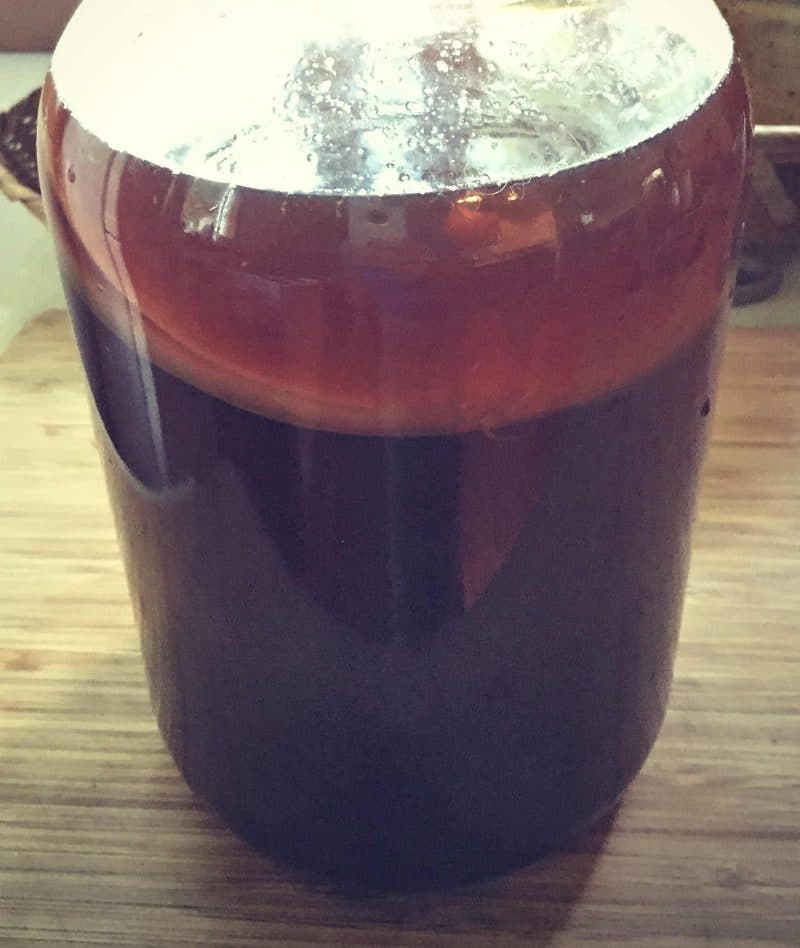
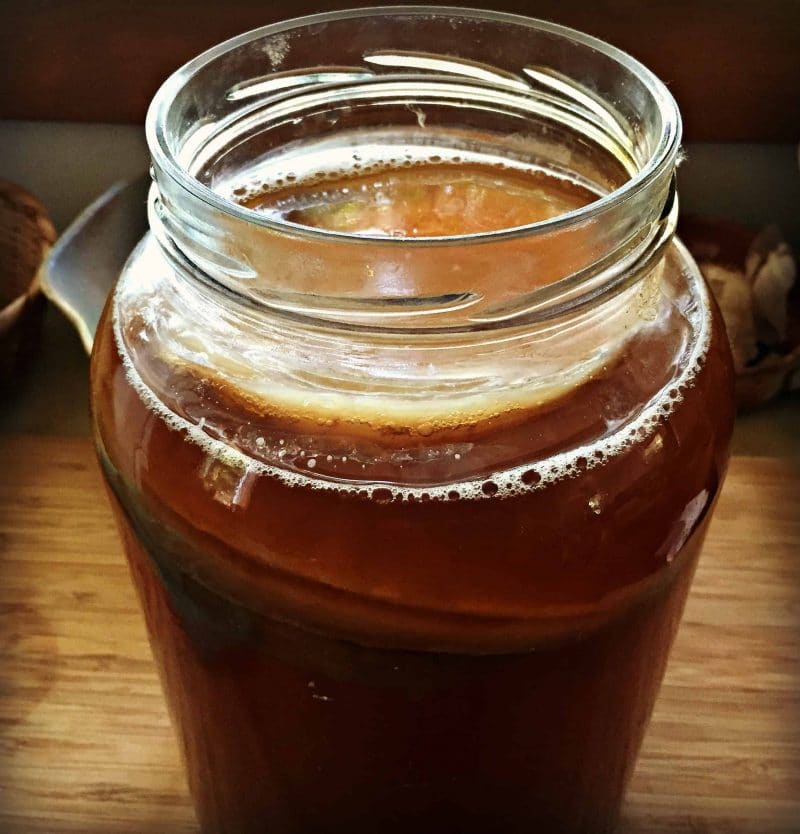
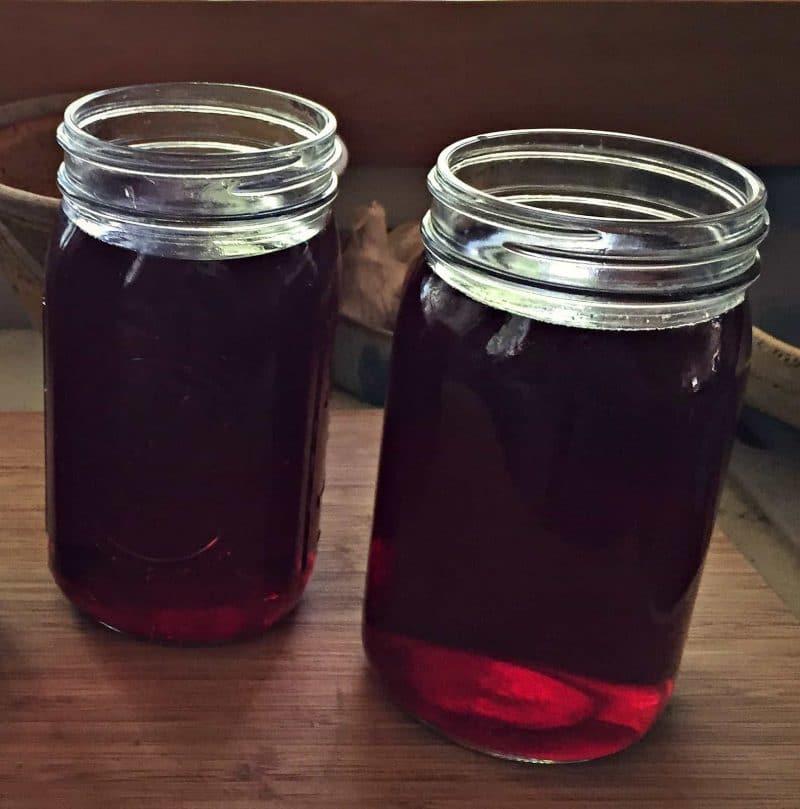
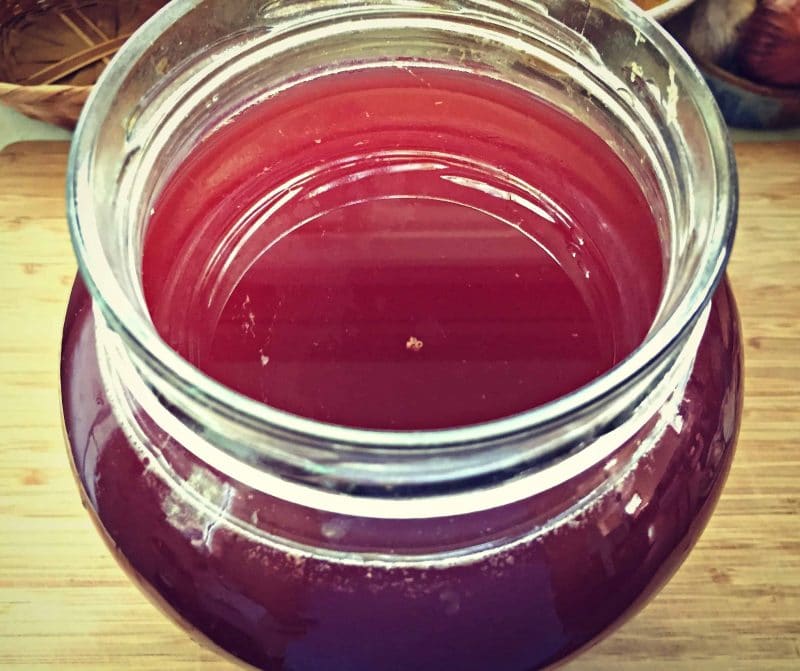
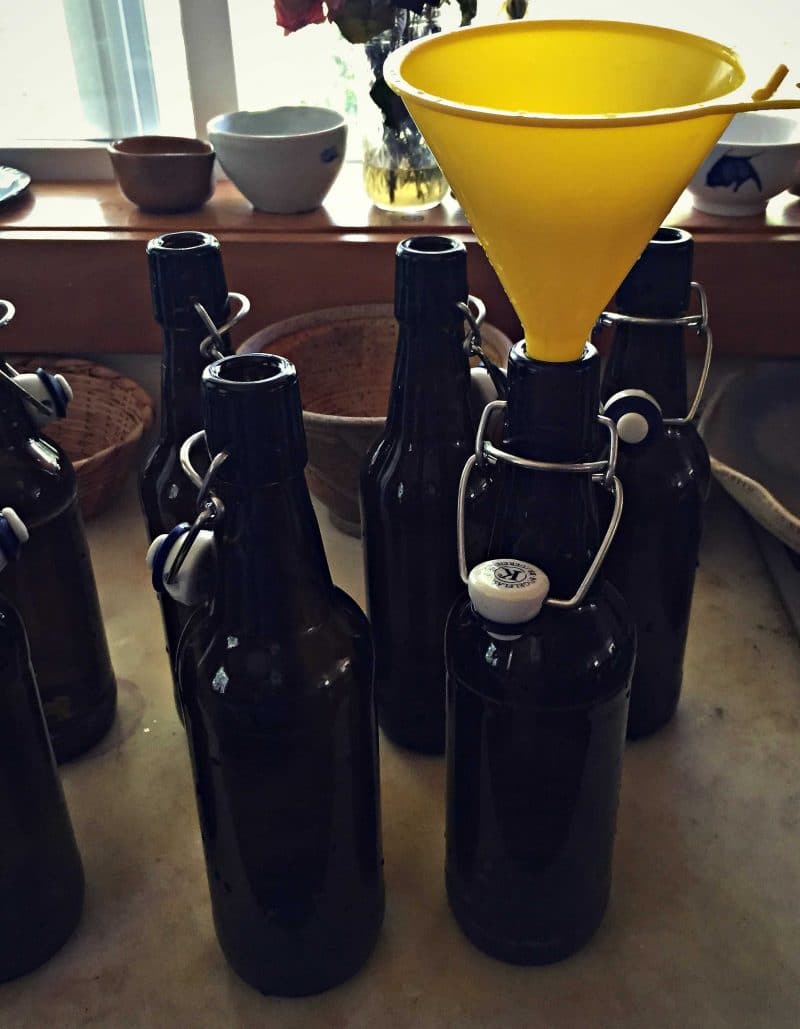
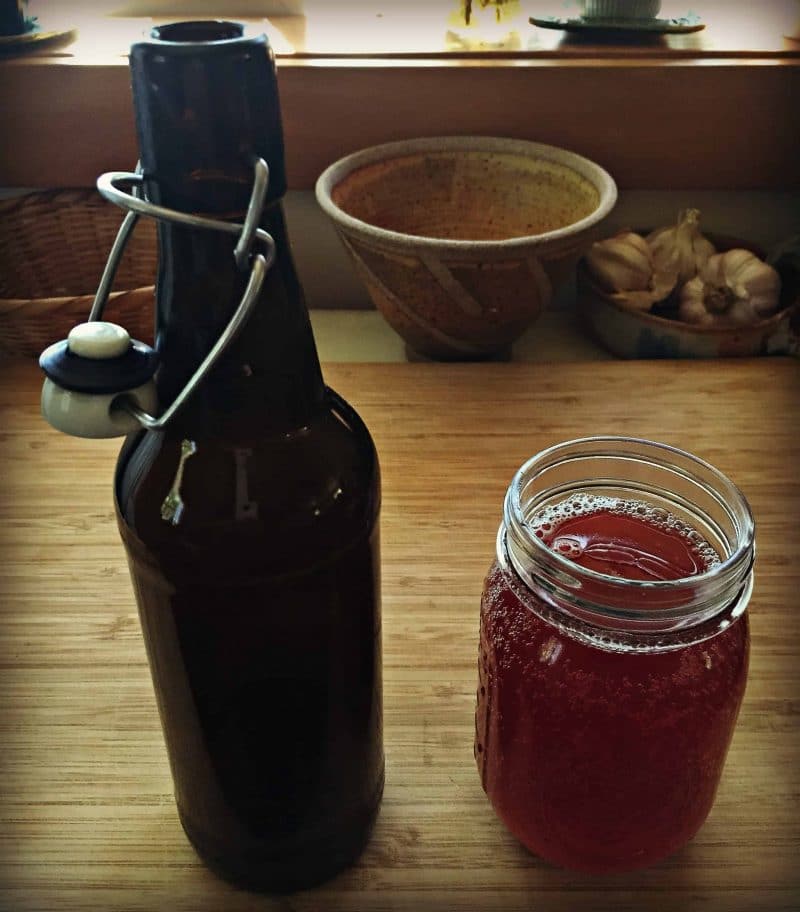
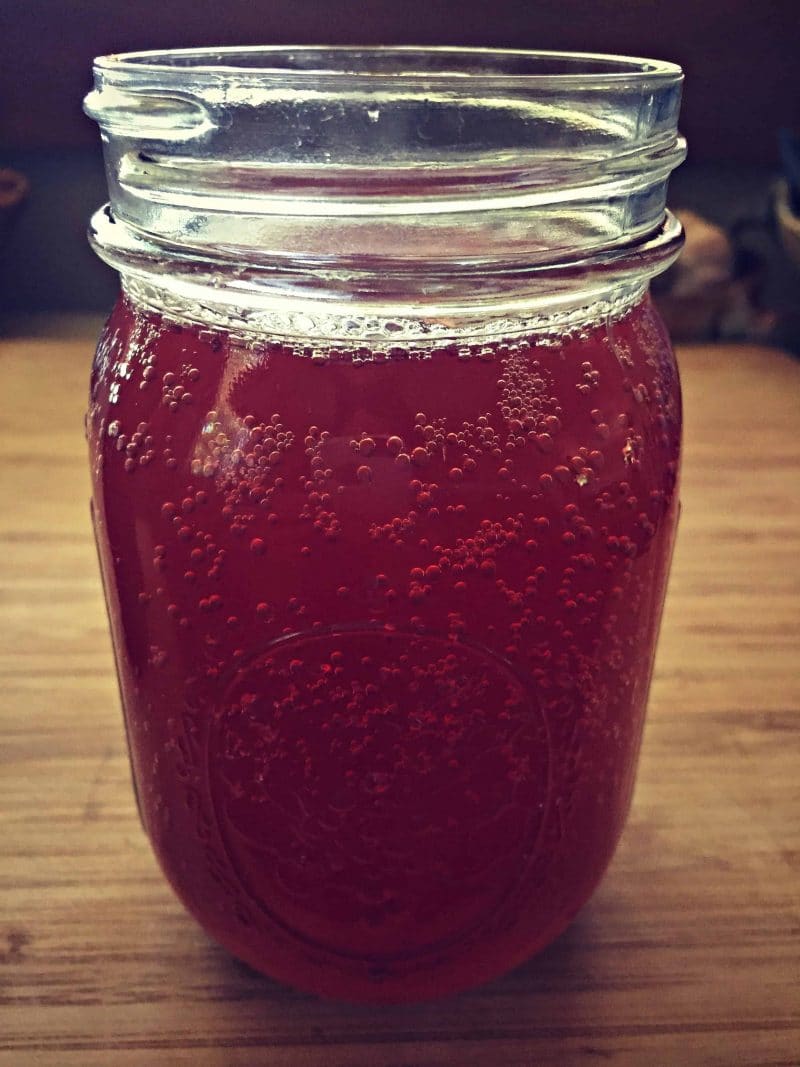


Can a SCOBY from an apple cider vinegar ferment be used to start making kombucha, or does the SCOBY need to come from kombucha?
Hi, Julie. Yes, you can use a fruit vinegar scoby to ferment tea into kombucha. I haven’t done it myself, but it looks like there are plenty of instructions online!
My favorite is frozen raspberries on the second fermentation part. I seem to be having a hard time though with getting it to be more carbonated. my first process I do a week and then I add the flavor and I let it sit for two to three more days… I’m looking forward to try and hibiscus
You may have too much space between the lid and the liquid. The gases need to be pushed back into the kombucha.
You can also add a couple raisins to your second fermentation – I use 2-4 in 16 oz Swing top bottles. The sugars in the raisins feed the yeast and add carbonation but don’t effect the flavor of Kombucha. FYI don’t eat the rehydrated rasins… they don’t taste good :D I leave my second fermentation for 3 days and don’t burp the bottles because I like it really bubbly. However if you add TOO many raisins you could have an explosion on your hands if you don’t burp the bottles.
Do you add sugar to your hibiscus tea for second ferment?
I do not add any more sugar to the second ferment.
I only add sugar for the first ferment Ginger goes very well in the second
Many have asked how much Hibiscus tea to add to second ferment, however, I can’t see the answer. Please advise. Thank you!
It’s really a personal preference and the amount doesn’t matter. I added enough hibiscus tea to equal a full gallon, but you can experiment with more or less to your liking :)
I just make hibiscus tea and don’t add any black tea
Do you ferment on your counter top? I was fermenting in a cupboard underneath my sink but I think it was too cold. What places do you recommend?
Yes, usually just right on my counter top, in an out of the way place :)
I would like to know what amount of kombucha to hisbicus tea you use is second ferment.
Looks like you said you made a follow of kombucha tea, less the two cups you must save for next batch.
Then you said to add hibiscus tea to kombucha and bottle. You don’t say how much hibiscus tea to use, and what ratio it should be to kombucha tea. Can you please let me know?
It’s really a personal preference and the amount doesn’t matter. I added enough hibiscus tea to equal a full gallon, but you can experiment with more or less to your liking :)
I am still not sure how much hibiscus tea you are adding to the black tea! Do you mean that you make the amount of liquid back up to one gallon – making up the amount left with scoby for next time?
Yes. After removing two cups of kombucha from your first ferment, fill the rest of the gallon of kombucha with hibiscus tea.
How much hibiscus did you use to make a gallon of kombucha? It’s my first time so I’m brewing 5 bags into 1 litter of water! Then I’m thinking of add a little bit to each bottle! Did you sweetened your tea before adding to the second fermentation? Thx in advance
Hay i used a few cloves and cardamon in a bottle as second fermenting. Wooooaash. The fragrance isawesome as well as the bubbly flavor… trying cinnamonsticks and staranise soon!
I am curious what sort of flavor hibiscus has during a ferment.I’ve tried hibiscus tea before but never in kombucha. This looks so interesting! What is your favorite flavor of Kombucha?
I use a cardboard carton over my glass kombucha vessel while its brewing. I need to leave it in the sun as its cold here now and I still want my Kombucha to brew without slowing down too much, so it’s sitting in the winter sun with a carton over it. It’s brewing even better than it did it more suitable weather :) As a bonus, I guess the cardboard would help curtail any flying glass :-o
I have only ever done the first stage brew, and just let it get to the fizzy stage and then bottle and fridge, and it’s scrumptious, but I’d like to check something, please, Colleen.
I use just enough black tea to keep feeding the scoby and use more rosella, or hibiscus, leaves as my primary flavouring, adding a little ginger and/or turmeric in the FIRST stage brew. Is there a problem doing it that way? I know that long term I have to increase the % of black tea, as the scoby needs that, but is there an advantage to the second stage brewing/ferment that I’m missing out on doing it my way?
My scoby is growing beautifully and the brew is very delicious and clean.
many thanks for all your sharing.
Will 12 oz canning jars be ok for the 2nd fermenting process?
I’ve only ever used fresh herbs for the second ferment. Could you give me an idea as to how much dried hibiscus you would use for a one gallon batch
Do you have to burp after you put in fridge too or just when in warm place while fermenting process
I have read that you can use wine bottles and corks for second ferment. Has anyone tried this? I would think that wine bottles that contained sparkling wines or champagne would be safe.
I have done this when bottling mead, and it does make it somewhat safer. But if there is a lot of pressure there is still the (very small) chance of bottle explosion.
I had actually done this with a used wine bottle. I used a cork that was purchased to use after a bottle of wine has been opened as to save it. It worked great! The pressure actually built up enough to pop the temporary cork out- but I would prefer that to an exploding bottle. Since that time I have purchased some flip top bottles used in beer making that is supposed to withstand pressure – but I still burp my second ferments daily until I feel it’s done.
I place the bottled kombucha for second ferment inside a plastic cooler. That way, if it does explode, it’s inside a container and it will control the flying glass. I also leave a towel laying over the bottles and carefully release the caps to “burp” them, while keeping the towel intact. Safety! Plus the juice that sometimes erupts will absorb into the towel, so it keeps the mess down. Haven’t had an exploding bottle yet, but I’m still pretty new at this. Got to give credit to my son for the cooler trick.
This is a great idea! i will be getting ready for my second ferment in a couple of days and was freaking out a bit when I heard about explosions, so this will be helpful!
Okay….the thing about exploding….should never happen if you leave enough head space in your bottles! Carbonation needs room! I’d never ever do a second ferment in a narrow bottle or the bottle you intend to store in your fridge either. Do it in the original large jars…gallon preferred or several quart jars and leave 1-3 inches headspace and all will be happy. Too funny…
Exploding bottles can still occur even when adding enough headspace… ask me how I know :)
After the first ferment, I fill a 1 quart jar with kombucha. I add 1/4 c crushed raspberries, 1/2 teaspoon of sugar, and 1 teaspoon of powdered chocolate to get it going again, and leave it on the counter for 4-5 days. Yum..
I learned the hard way too. Make sure to use good quality glass bottles, round, not square, that can hold pressure. If it’s hot, only ferment a couple days. I also use a plastic water bottle with some secondary kombucha as an indicator. When the bottle gets fat, the carbonation is building, so time for the fridge or to burp. I was using a cheap TJ Maxx square swing top bottle when mine exploded in the pantry. I like carbonation so I try not to burp and let it out, but in the fridge it quiets down.
burp your 2nd ferment bottles people??? what does this mean ? how to burp the bottles?
Burping the bottles means to briefly open them every day or so to let the gasses escape. In some cases, if the bottles aren’t burped they may explode because of built up carbon dioxide. I’ve never had this happen, but it is a possibility if there is a lot of residual sugars left when bottling.
only had an exploding bottle once and that was enough!
Please burp your 2nd ferment bottles people!
I can’t stress that enough. Lately my kombucha has been super strong and scaring me haha. So be careful. Some fruit like pineapple need to be burped and can cause huge explosions.
Listen to Jay!! I had a glass bottle blow up into daggers that stuck into the ceiling and walls of my pantry from a bottle sitting on the floor. It sounded like a bomb went off in my kitchen.. had I not been fermenting in a closed pantry I would have been severely injured. You can also use one plastic bottle as a control to test the level of carbonation by squeezing it. Be VERY careful with second ferments!
How often should they be burped?
Once daily should probably work just fine.
I’ve made kombucha with lemon balm (on the 2nd ferment). Actually, lemon balm and St Johnswort (I live in the North and like to have some St Johnswort when the days are especially short, and the window of natural light is very nearly non existent) I usually add a bit of ginger, turmeric root and pear or elderberry juice to make it taste better, and make the kombucha from a green/oolong blend.. In Spring, sometimes I do a burdock, dandelion root, licorice sarsaparilla decoction, sweetened a bit with some juice like black cherry, grape, bilberry or cranberry, and with a bit of turmeric root added to each bottle . For this I’ll use a kombucha made from an oolong/puerh blend. Summertime, I use a very strong tea of cornsilk, damiana, and horsetail or nettles, with added ginger and whatever berry juice I can get my hands on. In summer I prepare kombucha from a green/white tea mixture. Any real tea will work, as long as it is only tea and nothing else, no flavorings or herbs in the initial kombucha ferment. I’ve even made an apple pie 2nd ferment from calendula, ginger, cinnamon bark, nutmeg and apple juice – but never made anything with hibiscus. Looking forward to trying that. I love the flavour of kombucha on its own, and will keep a few bottles unflavoured, but its so much fun to play around with the 2nd ferment . Fairly new to other aspects of fermenting, like pickles and sourdough, and I really enjoy your site.
How do you ferment with the herbs if it isn’t in the 1st ferment? Do you make another tea from them and add to the second ferment? Just add the herbs straight? Would love to know! Thank you!
Most likely just adds the herbs/fruits to the 2nd ferment. There’s no need for more tea at that point and if there’s enough sugar left from the first ferment, the kombucha will carbonate regardless.
Remember to burp your bottles, fruit like pineapple can cause massive bubbles and explosions, so be careful.
What volume of hibiscus tea do you add to the 1 gallon kombucha tea? Thanks for posting, this looks delicious!
I added enough hibiscus tea to equal a full gallon when combined with the kombucha, but you can experiment with more or less to your liking :)
I notice you use a metal pot and a metal strainer. The instructions that I have say NOT to do that because the metal can kill the kombucha. So I have been boiling my water in a glass crockpot–which is not the most convenient thing to do because it has wide lips and the water tends to spill over. Don’t you have any problems??
It has always been my understanding that it’s ok to boil the water and steep the tea in a stainless steel pot, but that the actual ferment should take place in glass. That’s what I’ve been doing for many years without a problem!
I have been using stainless steel pots for brewing the tea and my scobys are growing like crazy. Just make sure you ferment in glass.